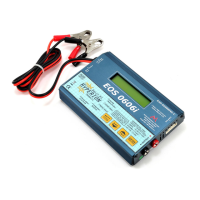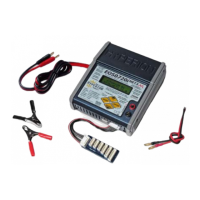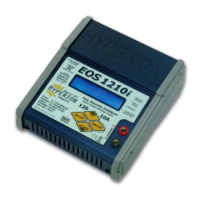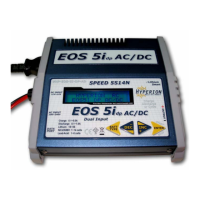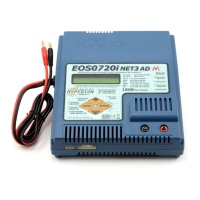HYPERION AC/DC EOS0606iAD-A USER’S MANUAL
Visit http://media.hyperion.hk/dn/eos for the newest manuals and news
EOS 0606i AC/DC Special Features
*Two INPUT power choices:
Use AC 100V~240V at home OR DC 11V~15V anywhere
*Powerful, yet compact and portable with wide support for battery types
*Integrated Hyperion LBA Balancer for LiPo (3.7v) and LiFe (3.3v) based cells
*Balance Multi-Adapter for 2S to 6S packs included (Hyperion Type)
*Charge and Discharge Modes (and Cycling for NiMh and NiCd)
*Clear and easy-to-read LCD Screen with Warnings common setup errors
*Packaged in a rugged aluminum case - Long Input leads
*Hyperion Balance Multi-Connector Included. Option multi-connectors for
most common brands are also available (see details end of document)
Specifications
Input voltage range
11.0-15.0V DC OR
100~240V AC at 50~60 Hz
Only ONE source may be connected at a time!
1-14 NiCd – Nickel-Cadmium cells
1-14 NiMH – Nickel-Metal Hydride cells
1-6 LiPo – Lithium Polymer cells, 100~20,000mAh (3.7V/cell type only)
1-6 LiFe – Lithium Iron (3.3V/cell types, inc. A123 brand cells / LiFePO4 cells)
Appropriate battery types and
range of series-connected cells
1-6 Lead-Acid cells (2V per cell nominal)
Charge current 0.1A ~ 6.0A MAX, by 100mA steps (50W limit)
Discharge current 0.1A ~ 1.0A MAX, by 10mA steps (5W limit)
Trickle charge current (NiCd, NiMH) 0 ~ 200mA
“Delta V” peak detection for NiCd/NiMH
Charge termination
“CV/CC” for Lithium and Lead-Acid Batteries
Cycling Modes (NiCd, NiMH) Charge>Discharge or Discharge>Charge
Display type 2-line, 16 character Yellow backlit LCD
Safety precautions
• KEEP CHARGER and BATTERIES AWAY FROM CHILDREN AND PETS AT ALL TIMES!
• This charger is ONLY for NiCd/NiMH, Lithium (3.7V/cell), A123 (3.3V/cell), and Lead-Acid (2.0V/cell)
type cells. DO NOT connect others, such as 3.6V/cell Lithium-Ion, or non-rechargeable batteries!
• Always place the charger on a firm, level, and fireproof surface for charging
• Do not place the battery or charger on or near flammable materials while in use:
Keep away from carpets, cluttered workbenches, etc
• Do not exceed cell manufacturer’s suggested max charge rates
• Do not use automotive type battery chargers to power the charger
• Do not leave the charger unattended while charging
• Do not allow water, moisture or foreign objects into the charger
• Do not open the charger, nor attempt any repair as it is dangerous and will void your warranty
• Do not obstruct the air intake or outlet holes on the charger
• ALWAYS follow correct connection sequence, as given below
• CAREFULLY FOLLOW THE BATTERY PACK MAKER’S RECOMMENDATIONS AND SAFETY ADVICE!
HIGH RISK CHARGING ADVISORY
Avoid charging batteries indoors. If you must charge indoors – or any place injury to persons or damage could result in the event of fire – then be sure to:
* Keep battery well away from flammables (2 meters or more)
* Contain battery in a heavy fireproof container (such as a brick box)
* Always monitor the charge
HYPERION ACCEPTS NO RESPONSIBILITY FOR DAMAGE OR INJURY FOR INDOOR or other HIGH RISK CHARGING ACTIVITY
Initial Setup
The EOS 0606i requires 4mm Bullet Connectors (aka Banana Plugs) on 12awg wire leads for output harness between charger
and battery main wires. Harness wire leads should never exceed 20cm in length. Pre-assembled output harnesses are
available under Hyperion Part #HP-EOSOUTCORD, and one harness is included with each charger. Solder your chosen
battery-side connector to the bare wire ends of the harness, taking great care to observe proper polarity.


